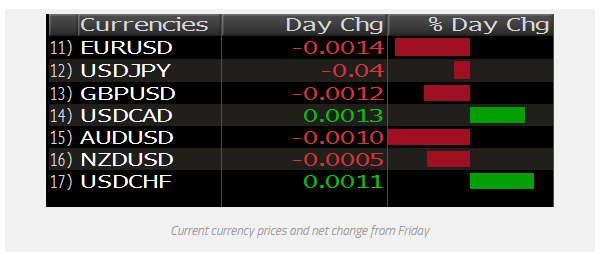If we had a crystal ball for this week it would probably say something along the lines of ‘proceed with caution, volatility ahead’. In a week of top tier economic data from both sides of the Atlantic, market participants will be watching US jobs data for November in what could present the final argument in favour of the Fed lifting interest rates…or not. In terms of market reaction it not about the result, it’s about expectations and its clear most are expecting the jobs data to add credence to a December rate hike. If it doesn’t, volatility will ensue and the US dollar will likely suffer the consequences. Before the main event, markets will be watching for other top tier data points with ISM manufacturing (Wednesday), Beige book and ADP employment data (Thursday) and ISM Services on Friday. Perhaps the key determinant for the greenback ahead of Friday’s NFP’s will be two speeches by Fed Chair, Janet Yellen.
Meanwhile, it’s just as exciting across the Atlantic with the much anticipated European Central Bank decision on Thursday. It’s a very different thematic for the Europeans who are debating the need to adopt further accommodative policy stance in the form of lower (negative) deposit rates. Banks currently pay -0.2% to park their funds overnight, and it’s expected that will be lowered to -0.3% on Thursday. The theory is the more it costs for financial institutions to park their money with the ECB, the less inclined they are to do so. The ECB are expected to keep interest rates at 0.05%.
Ahead of the meeting, the focus will be on the release of European consumer price index (CPI) on Wednesday. This is expected to show the ECB have more than enough spare capacity to increase stimulus with annual inflation expected to come in at 1.1% – well below the ECB’s target rate of less than 2%. In the lead up, on Tuesday German CPI and Unemployment data will be the key focus and seen as a precursor to the data releases later in the week.
On the domestic front, the first Tuesday of the month is always exciting for local rates pundits, with the RBA expected to ‘chill’ on rates and keep them at a record low 2%.
As noted in last week’s report, RBA Governor, Glenn Stevens’s poured cold water on the chance of a near-term rate cut. He was unusually ‘chilled’ in any case when responding to a question about prospects of interest rates being cut further, saying “we’ve got Christmas. We should just chill out, come back and see what the data says.” In a clear sign that that we won’t see another rate cut this year, Stevens further said he agreed with the argument that rates should remain at 2% when the bank meets in December.
Perhaps it is way of trying to subtly express some confidence. Over the years Stevens has expressed the importance on focusing on the positives, with negative views often leading to negative outcomes in ‘self-fulfilling prophecy’ type fashion.
Long Aussie traders need to see the same relaxed commentary from the Reserve Bank that we’ve seen in recent times from Governor Stevens. But it’s likely to be quickly forgotten on Wednesday when the growth turns to the release of third quarter GDP and market participants turn to what the bank will do in February 2016. Early expectations are for GDP growth of 0.7% (QoQ) and 2.3% (YoY).
While tomorrow’s rates decision is unlikely to be a major market moving theme, by default, the Aussie’s likely to be dragged along with USD volatility throughout the week as participants respond to economic data points, speeches and general conjecture in the lead up to NFP’s. China manufacturing data out tomorrow also has form of being a key determinate for the local unit.

Risk Warning: Trading Forex and Derivatives carries a high level of risk to your capital and you should only trade with money you can afford to lose. Trading Derivatives may not be suitable for all investors, so please ensure that you fully understand the risks involved, and seek independent advice if necessary. The FSG and PDS for these products is available from GO Markets Pty Ltd and should be considered before deciding to enter into any Derivative transactions. AFSL 254963. ABN 85 081 864 039.
Recommended Content
Editors’ Picks
AUD/USD could extend the recovery to 0.6500 and above

The enhanced risk appetite and the weakening of the Greenback enabled AUD/USD to build on the promising start to the week and trade closer to the key barrier at 0.6500 the figure ahead of key inflation figures in Australia.
EUR/USD now refocuses on the 200-day SMA

EUR/USD extended its positive momentum and rose above the 1.0700 yardstick, driven by the intense PMI-led retracement in the US Dollar as well as a prevailing risk-friendly environment in the FX universe.
Gold struggles around $2,325 despite broad US Dollar’s weakness

Gold reversed its direction and rose to the $2,320 area, erasing a large portion of its daily losses in the process. The benchmark 10-year US Treasury bond yield stays in the red below 4.6% following the weak US PMI data and supports XAU/USD.
Bitcoin price makes run for previous cycle highs as Morgan Stanley pushes BTC ETF exposure

Bitcoin (BTC) price strength continues to grow, three days after the fourth halving. Optimism continues to abound in the market as Bitcoiners envision a reclamation of previous cycle highs.
US versus the Eurozone: Inflation divergence causes monetary desynchronization

Historically there is a very close correlation between changes in US Treasury yields and German Bund yields. This is relevant at the current juncture, considering that the recent hawkish twist in the tone of the Federal Reserve might continue to push US long-term interest rates higher and put upward pressure on bond yields in the Eurozone.